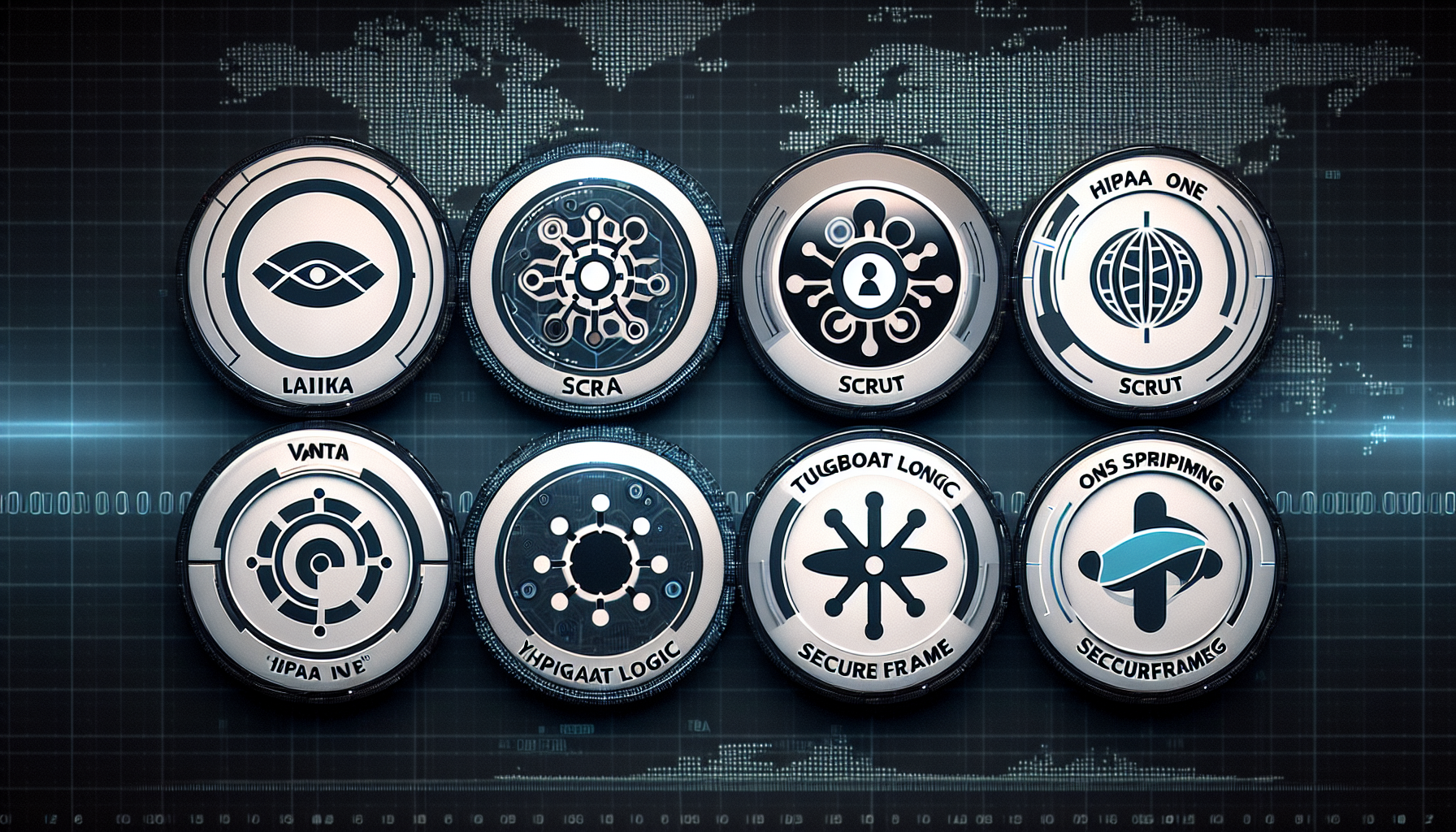
Streamlining Risk Management: A Guide to Automated Compliance Monitoring Tools in 2024
Written by InvestGlass on .
With regulatory demands growing more complex, automated compliance monitoring stands as a beacon of efficiency and reliability for businesses. By enabling real-time oversight and proactive risk management, these tools are reshaping compliance strategies. This guide will take you through the core advantages and actionable insights needed to understand and implement this technology in your day-to-day compliance operations platform and, safeguarding your business against non-compliance pitfalls.
Key Takeaways
- Automated compliance monitoring tools increase efficiency and accuracy, reduce risk of non-compliance and fines, and streamline data management and audit processes.
- Integration with existing systems, real-time alerts, and customizable dashboards are key features of automated compliance monitoring tools that enhance decision-making and maintain up-to-date compliance status.
- Successful implementation of automated compliance monitoring involves assessing compliance needs, careful deployment and integration, and provision of training and support for employees.
The Importance of Automated Compliance Monitoring

In the current corporate environment, having automated compliance monitoring systems in place is essential for maintaining effective operations rather than a mere convenience. By investing in such technologies, enterprises can achieve continuous compliance with legal and regulatory standards, enhance their resilience against potential violations of these requirements, and minimize exposure to risk. This is particularly vital for entities that manage delicate data. Integrating real-time information into one accessible platform ensures greater organizational effectiveness.
Utilizing tools like compliance management software to automate the process of managing adherence tasks represents an optimized approach to satisfying obligatory conditions. These advanced compliance automation solutions do not only reduce the need for manual intervention but also provide several key advantages: they improve overall business productivity, ensure higher levels of precision across workflows, accelerate the handling of data-intensive processes and offer capabilities that allow immediate reflection of changes through up-to-the-minute updates.
Minimizing Human Error with InvestGlass automation tools
Automation’s intrinsic ability to reduce human error is particularly beneficial in the realm of regulatory compliance. This translates into a reduced likelihood of non-compliance, lower risk exposure to fines, and significant savings in time. InvestGlass automation tools capitalize on this by taking over repetitive tasks involved in compliance processes and curtailing the probability of mistakes made by humans.
Consequently, there are fewer errors within compliance activities leading to decreased overall risks related to it while simultaneously lowering chances for penalties and fines. But that’s just scratching the surface when it comes to advantages.
By implementing automated compliance workflows, not only does one ensure greater accuracy in reporting and analysis regarding compliance matters, but also contributes critically towards establishing a strong foundation for both a comprehensive compliance framework as well as an effective risk management strategy.
Streamlined Audits
Previously, audits were often associated with being arduous and protracted. The advent of compliance automation tools has transformed this outlook significantly. These innovative instruments work in harmony with a variety of productivity tools to achieve several objectives.
- They consolidate the administration of both compliance tasks and related documentation
- Streamline auditing operations substantially
- Simplify the protocols for carrying out audits
- Provide assurance that audits are performed using current and precise data presented clearly on a dashboard
This modern approach has greatly improved how companies tackle audit processes by making them more efficient.
The impact? Audits have become sleeker affairs, requiring fewer hours and resources to get ready for an assessment while offering immediate insights into accurate compliance statuses directly to internal auditors and top management alike. An excellent case in point is InvestGlass, which deals in workflow application software. They managed to slash their preparation time needed for audits by half thanks to these automated compliance monitoring solutions.
Adapting to Regulatory Changes
The nature of regulations is ever-changing. Compliance management software cost automation tools enable prompt adaptation to these changes by alerting compliance officers and aiding in swift updates to the system. The sophisticated integration capabilities within a compliance management system are instrumental in automating the alignment of controls with diverse compliance requirements, simplifying conformity with numerous regulatory frameworks.
Updates and modifications pertaining to regulations are efficiently managed and disseminated through dashboards and specialized compliance instruments, fostering sound decision-making throughout the entity. Employing automated compliance procedures fortifies procedural observance, guaranteeing that operational methods remain current amidst the shifting terrain of regulation.
Key Features of Automated Compliance Monitoring InvestGlass Tools

In a technology-driven era, the power of AI cannot be understated. InvestGlass automated compliance monitoring tools leverage AI-based technology, such as Intelligent Indexing and machine learning, to streamline manual processes, minimize the chance of human error, and ensure accurate structuring and indexing of important documents. With AI, these tools relentlessly analyze data to identify compliance risks and potential gaps, superseding manual compliance checks and centralizing procedures.
Features that offer continuous monitoring, proactive issue tracking, simplified reporting, and actionable insights throughout the whole compliance lifecycle are also built into these tools. With customizable dashboards, such as those offered by InvestGlass, organizations can get a customizable view into the compliance status, including risk heat maps and audit reports.
Integration Capabilities
The fusion of systems in automated compliance management processes is critical for the accurate gathering of data and immediate detection of any deviations from compliance across multiple platforms. Compliance automation software melds effortlessly with common organizational tools such as Jira, Slack, and Microsoft Teams through a compliance automation platform, bolstering the management process by maintaining continuous oversight and handling of compliance information throughout different channels.
By leveraging integration features offered by monitoring instruments, stakeholders can benefit from an up-to-the-minute representation of their company’s adherence to regulations. This facilitates improved cooperative efforts between departments ensuring uniformity in managing compliances. For example, Very Good Security (VGS) provides an intermediary layer that aligns technological frameworks with regulatory requirements speeding up conformity with benchmarks like SOC 2 and PCI. Similarly, Cflow—a workflow automation tool requiring no coding—propels the efficiency in administering compliances while offering compatibility with more than a thousand applications.
Real-Time Alerts and Notifications with your existing core tools

In the rapid pace of today’s business environment, real-time updates obtaining information security compliance, are vital for enhancing decision-making and risk management. Automated compliance software systems feature alerting capabilities that continuously monitor the business, ensuring improved security posture and compliance. Immediate actions on detected anomalies via real-time notifications ensure that corrective measures are taken swiftly to maintain compliance.
Compliance automation tools:
- Scrutinize and monitor compliance procedures
- Issue alerts when potential compliance violations are detected
- Help to warn about compliance violation crises
- Provide a timely way to address potential issues before they escalate
- Enable instant problem resolution through real-time alerts
- Serve as an efficient compliance automation tool compared to manual processes
Real-time alerts enable organizations to promptly identify and rectify non-compliance issues, preventing penalties and reputational damage.
Customizable Reporting and Dashboards
Ensuring a robust grasp on the compliance position of an organization is critical for its effective management. Compliance automation tools come with customizable reporting features that empower organizations to modify how compliance data is presented, catering to various stakeholders’ needs and facilitating in-depth analysis through detailed drill-down options. The integration of a compliance management platform can augment these functionalities, promoting a thorough strategy towards further automating compliance monitoring processes.
The utilization of a compliance dashboard delivers a structured snapshot of an organization’s adherence to compliance program by:
- Keeping track and surveillance over information pertinent to specific obligatory requirements
- Generating immediate reports and notifications
- Enhancing transparency concerning adherence-related activities
These reports and dashboards offer adaptability as they can be adjusted according to different time periods, regulatory frameworks, or distinct business segments — enabling dynamic views into the organization’s state of conformity.
Implementing Automated Compliance Monitoring in Your Organization

The deployment of automated compliance monitoring is a comprehensive procedure that includes the following stages:
- Evaluating compliance requirements
- Executing setup procedures
- Integrating with existing systems
- Ensuring continuous maintenance and support
This process isn’t simply about introducing an automatic solution and expecting it to autonomously address every issue related to compliance. Rather, it requires a deliberate plan which includes assessing necessary compliances, setting up relevant tools, as well as providing education and assistance for staff members.
By adopting automated solutions for monitoring compliance tasks can be significantly expedited, thereby enhancing productivity while simultaneously establishing the organization as a trustworthy entity in the eyes of its clientele. Nevertheless, this implementation requires cautious execution since excessive dependence on or incorrect choice of automation resources could amplify risks, incur additional expenses and lead to more complex operations.
Assessing Compliance Needs
To initiate automated compliance monitoring within your organization, it is crucial to first recognize the exact rules and benchmarks that are relevant, such as those related to data security laws, industry-specific regulations, and financial reporting obligations. Subsequently, assess existing protocols and control mechanisms meticulously in order to identify any deficiencies or weaknesses concerning automation of compliance requirements.
For every regulation identified for this process, establish precise goals linked with the adherence needs. These could range from executing specific policies and reaching set security baselines to retaining essential records appropriately. Following this step involves selecting advanced tools designed for automation that align with your unique needs for compliance—these should support robust monitoring capabilities along with functionalities for report generation, safeguarding data integrity, and managing workflows effectively.
Deployment and Integration
Implementing and merging compliance monitoring tools into current systems is an essential phase. These instruments must be set up to record pertinent information and produce mandatory reports. Streamlining policies, assessments monitoring controls, and responses hinges on the successful integration of compliance automation software with established infrastructures.
Outlining the entire compliance process—from gathering data to analyzing it, right through to reporting—is crucial, inserting automation at every juncture. It’s important to devise a strategic approach that turns certification necessities into practical tasks while setting in place strategies for both mitigation and recovery.
Training and Support
Deployment and integration of compliance software tools work it is just the beginning. Effective use and ongoing support are crucial for automated compliance monitoring to work successfully. It’s essential that employees receive thorough training on the updated processes as well as on how to utilize these automation tools correctly, which will underscore their responsibility in upholding compliance standards.
To accommodate various preferences in learning, such as visual, auditory, or kinesthetic methods, training programs should be diverse. To maintain continual assistance post-training implementation, an appointed ‘automation champion’ could serve as a point of reference or alternatively, establishing a Centre of Excellence could prove beneficial by providing a resource to resolve potential problems while also promoting best practices through success stories sharing.
Top Automated Compliance Monitoring Tools for 2024

As we look ahead to 2024, organizations have access to an extensive selection of tools for automated compliance monitoring. Among the leading options are:
- Laika
- Scrut
- Vanta
- HIPAA One
Each provides a centralized dashboard that simplifies managing adherence to regulations including but not limited to HIPAA, GDPR, and various information security standards.
Tools such as Scrut Automation, Sprinto, Secureframe, LogicGate – with Onspring’s GRC software included – offer automation capabilities catering specifically towards compliance and monitoring across several industry benchmarks like SOC 2, ISO 27001. By automating processes like evidence collection in Scrut Automation or integrating standard procedures in Vanta along with streamlining entire compliance frameworks through Secureframe’s innovations. These systems work towards strategic compliance solutions easing the burden of maintaining regulatory conformity.
Overcoming Challenges in Automated Compliance Monitoring
Adopting automated compliance monitoring introduces several challenges, such as ensuring data security and adherence to compliance standards, maintaining scalability and adaptability of systems, as well as the necessity to update tools according to evolving regulations. These hurdles can be surmounted with an appropriate strategy and methodology.
One way to preserve document compliance is through version control measures which ensure that only verified and authorized documents are in use. By integrating cutting-edge security training tools like automatic smart security awareness platforms, companies can simultaneously bolster both cybersecurity measures and regulatory conformity.
Data Security and Privacy
Ensuring data security and privacy is a critical component of compliance automation. On average, remediating a data breach costs companies $7.5 million, highlighting the financial importance of implementing robust, security and compliance measures within automated compliance systems. Considering that 53% of organizations have suffered at least one third-party caused data breach, it’s clear that stringent checks for data security and privacy are necessary in these systems.
To bolster such defenses, compliance software leverages technologies like artificial intelligence (AI), machine learning (ML), and sophisticated analytics to encrypt information while complying with regulatory requirements – steps imperative for safeguarding against breaches. Nevertheless, even as these tools automate compliance and protection processes, they still require human oversight to ensure effectiveness. Without proper configuration or customization by skilled professionals, there remains an inherent risk for unauthorized system access and potential breaches.
Scalability and Flexibility
To sustain effective compliance monitoring in the face of ever-changing data protection regulations, it is critical that privacy automation tools be both scalable and flexible. This adaptability ensures they can manage the continuous updates necessary to stay compliant with the dynamic landscape of data protection legislation.
Case Studies: Success Stories in Automated Compliance Monitoring
Case studies offer tangible evidence of how compliance monitoring tools that are automated can significantly benefit organizations. A notable case involves a firm specializing in Internet infrastructure services which adopted MetricStream to maintain adherence to intricate rules, including those stipulated by SOX and HIPAA.
By incorporating MetricStream’s system, the organization was able to automate its operational procedures while creating a consolidated repository for controls. It also successfully integrated elements from COSO into their business operations. The outcomes were substantial. They included improved transparency and visibility, streamlined management of internal controls through automation, reduced risk associated with non-compliance issues, and vendor risk management and enhanced confidence among stakeholders.
Summary
In conclusion, automated compliance monitoring is a game-changer for businesses in 2024. By minimizing human error, streamlining audits, and swiftly adapting to regulatory changes, these tools help organizations manage risks, minimize fines, and ensure efficient operations. Key features of these compliance software tools include AI-based technology, continuous monitoring, proactive issue tracking, and customizable reporting and dashboards.
Implementing automated compliance monitoring, though challenging, is a worthwhile endeavor. By assessing needs, deploying and integrating tools, and providing training and support, organizations can effectively manage compliance, boost efficiency, and maintain a robust security posture.
Frequently Asked Questions
What does automated compliance mean?
Using technology to diminish the reliance on manual tasks and enhance the capacity to fulfill growing compliance obligations, automated compliance swaps out manual processes for advanced tools such as artificial intelligence.
What is the meaning of compliance monitoring?
Monitoring compliance involves the systematic practice of tracking and verifying that corporations are abiding by both internal policies and external regulatory mandates, pinpointing any potential risks to compliance in their activities.
The primary goal is to assist businesses in implement uniform compliance policies maintaining steady adherence to regulations and preemptively steering clear of instances of non-compliance.
How does automated compliance monitoring reduce human error?
Automated compliance monitoring reduces human error by automating repetitive tasks within compliance processes, which decreases overall compliance risk and the likelihood of incurring fines and penalties.
How do automated compliance systems adapt to regulatory changes?
Automated compliance systems alert personnel and assist in swift system updates to adapt to regulatory changes. They also ease adherence to multiple regulatory standards through automated control mapping.
What steps are involved in implementing automated compliance monitoring?
Begin by evaluating the compliance requirements to put in place an automated compliance monitoring system. Subsequently, set up and keep security controls, merge the required tools for monitoring into your systems, and offer adequate training along with support to staff members. This ensures they are well-informed and can efficiently utilize the automation tools provided for compliance purposes.